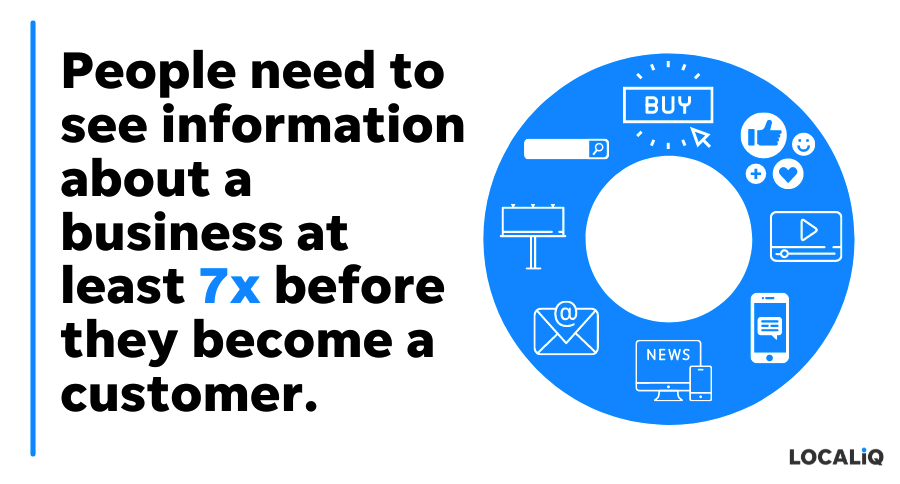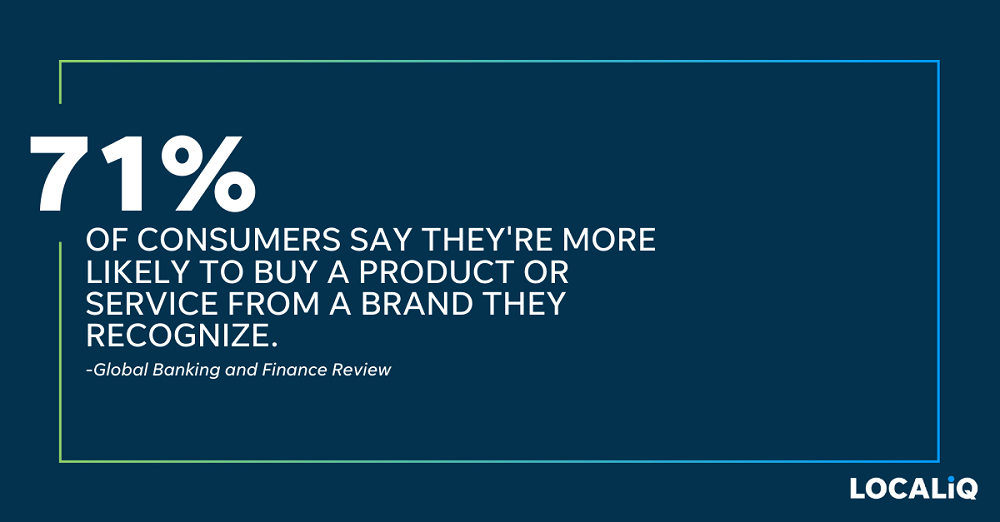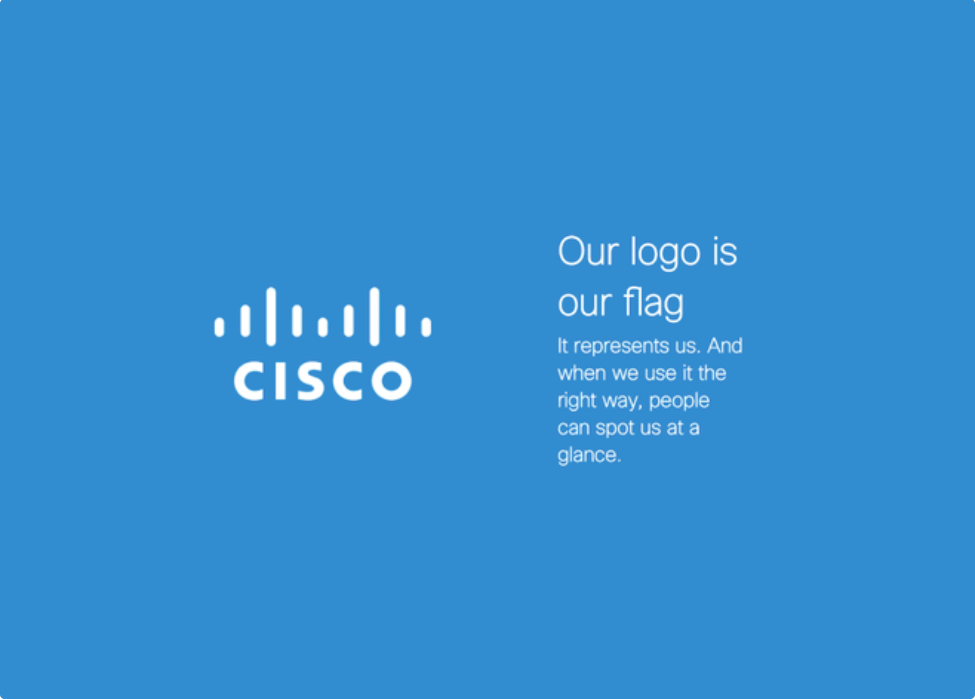Our hope is that every local business gets its chance at a “big break” to become a household name (or at least a household name in your community). But in order to get there, you first have to build brand awareness so you can attract more customers. However, that can be tough if you don’t have a solid brand to build awareness around in the first place!
While it’s easy to see examples of strong brands from big businesses like McDonald’s, Coca-Cola, and John Deere–it’s often difficult to find the same examples from small businesses. But the strongest small business brands follow the same principle big brands adhere to–and that’s brand consistency. So, today we’re going to help you understand how brand consistency can build long-lasting results by answering the following questions:
- What is brand consistency?
- Why is brand consistency the key to successful marketing?
- How do you build brand consistency?
Once we wrap up, you’ll be ready to master brand consistency and build a business and brand that customers recognize right away.

What is brand consistency in marketing?
Brand consistency is at the root of your business’s identity. It encompasses all aspects of your marketing—from messaging to design, how you communicate, and everything in between! Basically, any place a customer would engage with your business digitally or in the real world should have a consistent experience (and a consistent look and feel).
When applied in marketing, brand consistency signals to customers that your business has a strong brand identity that is easily recognizable—no matter where they’re seeing information about your business or engaging with your brand.

Why does consistency matter in marketing?
Why is maintaining that “image” and stability in branding so important to your customers? Shouldn’t they just know and trust you right off the bat? Unfortunately, we wish that were true (it would make marketing so much easier). But since we know that’s not always the case, here are some reasons why consistency in marketing is so important.
Consistent branding makes you memorable
Repetition is the reason why flashcards, lists, and pneumonic devices are so effective—the more often people see, hear, or experience something, the better. In fact, the age-old marketing “rule of seven” still rings true today in that people need to see, hear, or read something at least seven times before recalling it.
If you want your brand to be memorable (especially across your different marketing channels), then you need brand consistency. When your audience sees your brand across different marketing channels, they’ll be more likely to remember your business when deciding who to buy from.

Brand consistency contributes to brand recognition
Have you ever walked past a billboard, heard a TV commercial, or seen an ad online and automatically knew what company it was for? Recognizing an Old Spice, Geico, or Neutrogena commercial without ever hearing the brand name is a perfect example of brand recognition due to consistent marketing.
71% of consumers say they’re more likely to buy a product or service from a brand they recognize. If a customer was choosing between two products—one from a brand they recognized and one from a brand they had never heard of or seen before, they’re probably going to go with the brand they know.
Brands with distinct brand and marketing consistency are able to benefit from being easily recognized, which can help save money, build your brand, and increase trust.

Brand consistency builds awareness
Brand and marketing consistency helps to build awareness that allows customers to easily and immediately recognize your brand. Businesses with brand consistency are 3.5 times more visible to customers, which can help your business stand out in a crowded marketplace and get more prospects to learn about your business and become customers down the road.
Related: Find out how to measure brand awareness here.
Consistency in marketing can increase revenue
Did you know that the average revenue increase attributed to brand consistency is 23%? And choosing consistent brand colors can increase recognition by up to 80%!
Those statistics can mean a huge difference for your business. We know that consumers prefer brands that remain consistent in their messaging, logos, and marketing efforts, so make sure you aren’t missing the mark.
Giving your customers a reliable experience with consistent voice and tone will help to bring new and returning customers to your business more frequently—which drives more sales. Need we say more?

Brand consistency creates trust
If you had a friend that regularly broke plans, missed your phone calls, and didn’t return important texts, you probably wouldn’t have a lot of faith in that person. Being trustworthy is a major element of a successful brand. 81% of consumers said that they need to be able to trust the brand in order to buy from them.
If you aren’t consistent with your brand marketing, then you’re leaving your audience wondering what’s at the heart of your business. Your frequency as well as cohesive voice and tone reflects on your business, so you’ll want brand consistency to come off as trustworthy as possible.
10 tips to build brand consistency
It can be tough to know where to start when it comes to creating consistency in marketing. This rings especially true when your business is already established and you feel like none of your branding really aligns. Here are 10 tips you use to build brand consistency whether your business is new or 100-years-old!
1. Have a mission statement
A mission statement can be your business’s “guiding light” when it comes to brand consistency. A mission statement tells the story of what your company is and how it functions in the world. So, if you’re unsure of where to start in terms of branding, then a mission statement is a great initiation point since it can help clarify what your brand should be working towards.
Need help writing one? Start with these four components:
- Use easy-to-read language
- Put your unique value on display
- Push for memorability
- Maintain a “big picture” point of view

2. Create brand guidelines to avoid mistakes
Part of building a cohesive brand is establishing the same voice across all your marketing assets. If the copy on your website sounds like it was written by a serious British butler, but the posts on your social media account seem like the work of an emoji- and meme-obsessed teenager, people are going to be confused.
A great way to avoid that is by developing a set of brand guidelines, which can include things like:
- Descriptions of tone and voice
- Grammatical and stylistic preferences
- Social media examples
- Hex codes of your logo
- Examples of competitors you’re shooting to imitate
- And more!
Very specific guidelines will leave no room for error which will guarantee branding accuracy and consistency. A brand guideline document can help to ensure that anyone—from your head of marketing to the intern who started yesterday—can write messaging that sounds like it came from your business.


Related: Get templates, examples, and tips to build an impactful small business brand kit.
3. Use the same color palette everywhere
As we mentioned earlier, choosing consistent brand colors can increase recognition by up to 80%! Developing a set color palette for your brand is a great way to build that instant recognition. That way you can incorporate those same colors into all your marketing collateral.
For example, when you see pink and orange, you automatically think Dunkin’ Donuts; when you see a drink with a green straw in it, you instantly know it came from Starbucks.
There’s a lot of interesting research about the psychology of color and how to use color as an advertising technique, so think about developing a color palette that makes the most sense for the messaging you’re trying to convey. For example, yellow can relate to positivity, while blue is considered soothing. And, if you’re not a design expert, you can work with a brand marketing company that has its own experts to help with this.

4. Put your logo on all assets
Along with your color palette, your logo is going to impact your brand recognition. It only takes 10 seconds for consumers to form an opinion about your logo. So, think of your logo as your brand’s “first impression” and one of the easiest ways to introduce brand consistency. Any place you can include your logo, you should include your logo. And, that logo should align with your palette.
5. Source and support reinforced brand efforts internally
Speaking of brand guidelines, you already know you may have folks from various departments and levels putting out content that is public-facing. So, on top of ensuring all your employees are familiar with brand guidelines, you’ll also want to ensure they’re putting it into practice.
Whether it’s a client invoice being sent out from finance, or a new policy being pushed out from human resources, you’ll want those items to buttoned up according to your brand. While it may seem minor, this will not only present a consistent brand to current customers but will also reinforce the brand to your employees so that they may become your brand “cheerleaders.”

6. Keep a consistent schedule for your marketing
Another way to build brand consistency in your marketing is to create a schedule for all your marketing activities, including your campaigns, your social media posts, and any other content you create.
Posting your content on a regular basis at similar times will help to build trust. When you post blogs or social content regularly, then people know what to expect and can rely on seeing your brand pop up on their screen.
The same goes for your campaigns—if customers know you send an email newsletter at the beginning of every month with coupons and specials, they’ll know to look out for it and grow used to seeing and engaging with it.
Work smarter not harder by using online tools to schedule your content. That way you can “set and forget” your posts with the peace of mind that you’re staying consistent.

7. Be thoughtful (even picky) when it comes to content topics
Brand consistency also applies to the type of content your business is creating. While it can be tempting to cover everything under the sun if it all relates to your business, that’s going to work against your brand consistency. Your brand should push you to have “tunnel vision” when it comes to picking out relevant, shareable marketing content.
For example, if your plumbing business creates regular content about plumbing FAQs and how to deal with plumbing emergencies, it wouldn’t make sense to also cover lawn care tips or the latest pop culture news. That’s not consistent with your brand.
8. Keep your brand consistent across all channels
When you think about your branding, it’s easy to only think about the main areas of your online presence: Your website and your social sites. But don’t forget that in order to have a truly consistent brand in marketing you’ll have to have all hands on deck. That means you should edit your PPC ads to align with your brand messaging, your email marketing should match the branding on your website, and so on.
Since you’ll be capturing your audience in all corners of the online and real world, you don’t want anything slipping through the cracks in terms of brand. We recommend making a list of all places potential customers may see you and then brainstorming how you can apply branding to each of those channels.

9. Run brand audits regularly
One of the toughest challenges that comes with branding is staying on track with your messaging. Therefore, you’ll want to carve out time for regular audits of your branding to make sure things like your blog posts, social posts, paid ads, and local listings all stay cohesive and align with the “big picture.”
Keep yourself in check by taking a step back every so often (we recommend monthly, quarterly, or yearly depending on bandwidth) to ensure brand consistency is running like a well-oiled machine.
Not sure what to look for? Start with a SWOT analysis of your brand versus your competitors!
- Strengths: what your brand does well in terms of consistency and recognition.
- Weaknesses: what your brand consistency strategy needs to improve on.
- Opportunities: what you can do to elevate your brand.
- Threats: who or what else might be applying the same or better branding tactics.
10. Create a cohesive online and offline presence with your brand
As you work hard to create consistent branding for all your marketing, don’t forget about your offline marketing and customers’ in-person experiences with your business. If you have a beautiful and cohesive online brand but it doesn’t match your storefront or align with your in-store palette, you might be losing that trust you worked so hard to build. Elements like signage, business cards, the color palette of your location, employee uniforms, or car wraps are all examples of true commitment to brand consistency on and offline.

Brand consistency is doable for any business
We walked through countless ways brand consistency can be applied to all aspects of your marketing strategy. And, with no sign of the importance of brand consistency in marketing going away any time soon, it’s safe to say that an overall branding plan is worth a shot—regardless of your business type or size. Every business has its own personal style. Hold onto that style to let it flourish and grow into a revenue-driving force!






